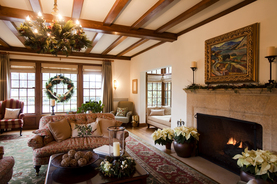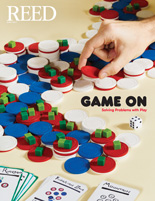
IRIS login | Reed College home Volume 96, No. 2: June 2017
Parker House Featured on Holiday Tour
Geography made Reed College and Eastmoreland neighbors and—to borrow a quote from President Kennedy—history made them friends.
Grand sponsor of this year’s Duniway Holiday Home Tour, Reed College opened Parker House to the public as one of five homes on the tour. Proceeds from the annual event, which took place Dec. 2, benefit Duniway Elementary School, a mile south of the college on Reed College Place.
"Reed College and the Eastmoreland neighborhood grew up together," said Jennifer Bates, director of public affairs for the college. "The college’s centennial was an opportunity to strengthen that relationship and showcase this jewel of a house to benefit the neighborhood school."
Organized by the Duniway PTA, the tour provides funding for classroom materials, enrichment programs and student field trips. More than $28,000 was taken in from this year’s event and over 600 people took the tour. Participants were transported by trolley to five homes in the neighborhood, including an English Tudor-style home and a classic English cottage.
Completely renovated and decorated four years ago, the house was trimmed for the holidays by interior designer Kathia Emery ‘67, a Reed alumna and Eastmoreland neighbor. Nodding to the college’s history, Emery incorporated items that included a letter sweater thrown over the back of a chair and a gilt mirror faced with griffins.
"Decorating the Parker House for the tour was a perfect way for me to give back to the college," Kathia says. "The house is architecturally very interesting, so it’s wonderfully elegant without the holiday decorations. But I enjoyed the opportunity to dress up this beautiful mansion for the holidays and make it feel like people actually live there. I am grateful to Gay Walker ‘69, the Reed College special collections librarian, for loaning books and objets d’art for the project."
Throughout the day of the tour Kathia overheard many people remark how grateful they were to the college for restoring Parker House and opening it to the public for the tour. Two former owners who still reside in the neighborhood toured the home and shared stories about when they lived there.
Partners and Friends
The development of Reed College and Eastmoreland is the story of two friends. Both were sited on the Crystal Springs Farm, land belonging to the Ladd Estate Company, founded by William Sargent Ladd.
Ladd was partnered with his friend, Simeon Reed, in many business ventures from the time they both arrived in Portland, in the 1850s. Their spouses, Amanda Wood Reed and Carolyn Elliott Ladd, emigrated together by sea from Boston in 1854 and were lifelong friends.
Amanda’s 1904 bequest seeded Reed College and William Mead Lamb, son of William S., donated 40 acres of land to the Reed Institute for a campus.
A newly minted Reed College trustee, William Mead Lamb hoped the college would help spur the sale of 1,270 home sites in an adjacent subdivision named for judge Julius Caesar Moreland. Initial sales were not brisk and the Ladd Estate Company donated another 150 acres to the city for the formation of a municipal golf course, which by 1917 formed the western boundary of the enclave.
Prime sites were still available in 1929 when Mary Parker selected a steep lot across from the college that rolled down to the Eastmoreland Golf Course. The widow of Cyrus Parker, Mary had assumed the presidency of her husband’s company upon his death in 1927 and sat on the boards of his other companies.
In 1923, Cyrus Parker and his business partner, Thomas Banfield, acquired the Portland Wire & Iron Works, a small company whose products included a clumsy automatic coal stoker. Parker improved and patented the invention, spinning off a new company called Iron Fireman. Sales were brisk for the automatic stoker, which improved coal’s viability for heating homes and further fueled the Parker fortune. Cyrus Parker died on a company trip to Ohio when the airplane he was traveling in made an unsuccessful crash landing.
Two years later Mary hired architect Morris Whitehead to design a home for her and her five children: Ralph, Lois and Dorothy from her marriage to Cyrus, and Dina and Vigio Visetti, whom she adopted when their father died in 1926.
Whitehead had been the architect for the Temple Beth Israel, built by Parker and Banfield’s construction company. Other Whitehead work from this period include the Gus J. Solomon United States Courthouse and the University Club, both in downtown Portland, the Sixth Church of Christ the Scientist on the South Park Blocks and the original Multnomah Civic Auditorium (now Jeld-Wen Field).
For Mary Parker he designed an imposing Arts and Crafts home with a hipped roof and a central front extension. A hipped roof refers to one where all sides slope downwards to the walls without gables. Spacious rooms with impressive views opened around a central rotunda, which featured a curving stairway and wrought iron balustrade worked with northwest fauna.
President of the renamed Portland Wire and Steel until her death in 1962, Mary was active in both charity and social circles. As her children grew up and left home, she took in student boarders from the college and hosted get-togethers for young scholars because she liked their company. Eventually she moved to a smaller house in Northeast Portland and in 1955 her daughter, Dorothy, sold the house and parceled off some of the adjoining grounds. The William Crooks family owned the home until 1964. Ole and Joanne Lilleoren purchased the home, raised two daughters in it and sold it to Reed College in 2004.
The college hired ZGF Architects to design an adaptive reuse of the mansion. The primary entrance became the one facing the original carriage lane and the former front entrance was outfitted with an elevator to increase public access. An industrial kitchen provides dinners for as many as 16 sit-down guests in the dining room.
Four years ago the college began using Parker House to host campus-related meetings and retreats in the multiple meeting spaces. Three guest rooms provide overnight accommodations for visiting lecturers, academics and board members. Guests are shuttled from the west parking lot to preserve street parking for Eastmoreland residents.
"President Diver hosts dinners with the faculty here and we host Gray Fund dinners where students get to use the house," says Colby Westhead, Parker House manager.
The Parker House, long an Eastmoreland cornerstone, links the college and the neighborhood.
"We value where we live in Southeast Portland, and enjoy our neighbors on all sides of campus, including Eastmoreland," Bates said. "We are committed to being a good neighbor and look forward to another hundred years together!"
Tags: Parker House



LATEST COMMENTS
steve-jobs-1976 I knew Steve Jobs when he was on the second floor of Quincy. (Fall...
Utnapishtim - 2 weeks ago
Prof. Mason Drukman [political science 1964–70] This is gold, pure gold. God bless, Prof. Drukman.
puredog - 1 month ago
virginia-davis-1965 Such a good friend & compatriot in the day of Satyricon...
czarchasm - 4 months ago
John Peara Baba 1990 John died of a broken heart from losing his mom and then his...
kodachrome - 7 months ago
Carol Sawyer 1962 Who wrote this obit? I'm writing something about Carol Sawyer...
MsLaurie Pepper - 8 months ago
William W. Wissman MAT 1969 ...and THREE sisters. Sabra, the oldest, Mary, the middle, and...
riclf - 10 months ago